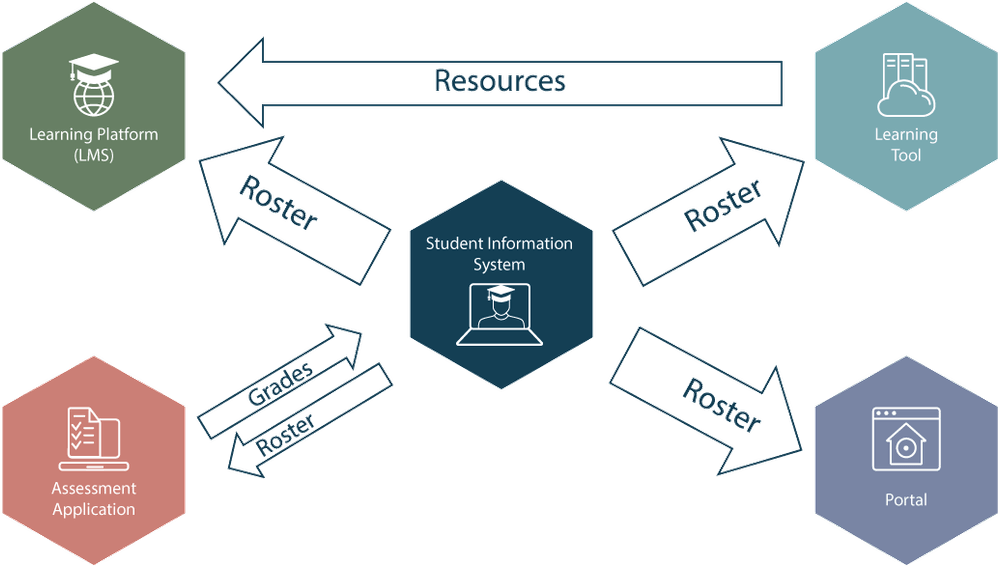The marketplace for eLearning applications and services has grown rapidly over the years driven by improved technology, and an increase in access to that technology. As more and more people and institutions move online, technology has become a more integral component in the learning environment.
Covid-19 forced most schools to go online, however many schools, and vendors, were not prepared for the sudden transition to a fully virtual learning model.
As a result of the shift to remote eLearning, schools had to quickly deploy a variety of applications. Most of these apps were self-contained systems with proprietary interfaces, making it very difficult to share data with a school’s learning management system (LMS) or student information system (SIS).
While it is possible in some cases to develop custom integrations, Aristek Systems takes a much better approach by rolling out eLearning applications and systems that support well-developed industry standards for communicating and sharing data. In this article, we will review six eLearning standards that Aristek Systems uses when developing eLearning solutions.
IMS global protocols: LTI, grade pass back, deep linking, QTI
LTI
Learning Tools Interoperability is an industry standard developed by IMS Global that is focused on allowing different LMS applications to talk to one another in a consistent manner. Over the last several years there has been a significant increase in the number of learning applications available in the market. In a perfect world, a learning management system (LMS) should provide access to all these applications, and it ought to be possible for these applications to share information with one another.
The LTI standard solves the problem of connecting learning apps and systems by defining a common framework for accessing and sharing information.
There are three key objectives to the LTI standard.
- Provide a simple mashup-style deployment in a URL format that can be used easily by LMS administrators and instructors.
- Define a protocol for launching applications from an LMS using single-sign-on (SSO), which eliminates the need for multiple user accounts for each application.
- Make links to external applications portable using a common data format. This is helpful when migrating an LMS or application.

Read More: Your Guide To LTI & LTI Advantage Standards
Grade Pass Back & Deep Linking
In recent years, the new IMS protocols Grade Pass Back and Deep Linking have emerged as significant features allowing a mirrored experience of the vendor’s application within a compatible LMS which also passes assessment scores to the teachers grade book.
QTI
QTI (Question and Test Interoperability) was the original protocol before Grade Pass Back and Deep Linking, used by vendors to share assessments to an LMS and capture the scoring results. Many LMS and other Assessment Systems still require the QTI format making it still a commonly used option.
QTI is ultimately an abstract data model used to store domain-specific data models. It also provides for an XML definition that enables communication between eLearning applications. QTI’s goals are:
- Provide a well-documented format for storing and exchanging data
- Support the deployment collections of items (questions)
- Provide a well-documented format for storing and exchanging tests
- Report test results in a consistent manner
SCORM
SCORM is another, older eLearning interoperability standard that tells software developers how to build applications so they can talk to each other. SCORM stands for Shareable Content Object Reference Model and allows content authors and developers to easily distribute their content to a variety of LMS’s.
SCORM describes specifications for the following areas:
- Content package — how content should be packaged and described. SCORM Content Aggregation model specifies that content should be packaged into a self-contained directory or zip file, along with a manifest file that contains metadata that an LMS will need to deliver the content. The manifest is also responsible for organizing all the course parts into an activity tree.
- Run-time — how content should be used and how it communicates with an LMS. Run-time specification is an ECMAScript that tells the web browser whether to launch the content in a new window or in a frameset.
- Sequencing — how a user can navigate between sections of a course as defined by the manifest file in the content package.
Automated Data Integration
IMS Global Standard: OneRoster
One of the more time-consuming activities an instructor or technical administrator performs is publishing staff, student and student roster information to applications that require access to student lists. A common example of the most desirable processing is the ability within an application, LMS, etc. the ability to merge all required staff, especially teachers, students and student course enrollments to teacher sections automatically. This allows teachers to assign to their entire class assignments rather than to each individual student which is a considerable time saver.
OneRoster is a newer, industry accepted standard from IMS Global for securely performing data integrations of staff, students and class rosters between an SIS and vendor applications, LMS’s, etc. OneRoster supports both CSV file processing and a REST-style API for direct system-to-system integration.
OneRoster supports three types of services:
- Formative and summative scores (Grades)
- Course resources (ex. Digital textbooks)
- Course enrollment information (Staff, Students and Course Enrollment)

Read More: What Is OneRoster? Your Guide To The Roster Sharing Standard
Ed-Fi
Ed-Fi is a data standard designed to allow educational systems to easily share educational data. Almost all learning applications store and access data in their own way using their own proprietary formats and structures, making it nearly impossible to share data between disparate systems. In this situation, there is no single view and no ability to correlate or analyze data. Ed-Fi was created to solve this problem by defining a set of rules for collecting, managing, and organizing educational data.
Learning applications and management systems that are built using the Ed-Fi framework, can more easily interoperate with each other since the underlying data structure is well understood and standardized. Ed-Fi specifically defines data models for more than 17 base domains in the K-12 education space. Some of these domains include:
- Student academic records
- Assessments
- Student attendance
- Bell schedules
- School calendar
xAPI
The Experience API (xAPI) is another open-source specification maintained by Advanced Distributed Learning group that is used to capture a learner’s online and offline experiences. The goal of xAPI is to allow different eLearning applications and LMSs to share and access these experiences in a standard way.
The API is commonly used with mobile learning apps, virtual worlds, social learning, and real-world activities to bring those experiences into an LMS or to share with other eLearning platforms.
Experiences can be thought of as activities that people perform when engaged in a learning opportunity, either online using a particular eLearning application or offline using digital tools in a physical classroom. xAPI records these activities as data. This data can then be used to help track and quantify a person’s learning progress. Activities are stored as simple statements using a noun, verb, object format, such as “I completed this activity.”
Experiences are stored in a Learning Record Store, which serves as the central repository for all activities managed by the xAPI. This is typically implemented as a web application that can receive xAPI requests and store them in a compatible database.
With a Learning Record Store, a person’s activities can then be shared with other systems, including a learning analytics platform (LAP), which can be used to help instructors make adjustments or recommendations to a student’s curriculum.
Conclusion
In this article, we reviewed many useful methods of integrating data and content that Aristek Systems uses to develop applications and platforms that are able to interoperate with each other. Systems based on these standards can readily publish, share, and access data. When systems are built using a set of standards, your TCO is significantly reduced.





